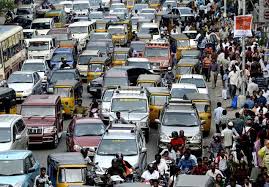There are about seven and a half million cars in Delhi, which is about double the population size of a country like Singapore. Every day, traffic jams delay efforts by ambulances. About 60% of deaths happen within the first half an hour of an accident and one of the reasons for this is that it is too late by the time the ambulance reaches the hospital. It’s not just during emergencies that people in Delhi suffer due to traffic jams but they have become troublesome even for commuting on a daily basis. People waste about Rs.54 crores worth fuel due to traffic jams in India every year.
However, it is not just the money that is being wasted but also other important resources like time which gets wasted when people sometimes take two hours to cover a certain distance in Delhi which can be covered within half an hour in the absence of traffic jams. The levels of fatigue have increased due to this and the quality of life has gone done considerably. Congestion is also affecting the quality of air in Delhi making it one of the most polluted cities in the world.
All these factors highlight the need of a well-developed congestion pricing system in Delhi.
Electronic Road Pricing, a road pricing model successfully implemented in Singapore under their then prime minister Lee Kuan Yew can serve this purpose. Based on a pay-as-you-use principle, motorists are charged when they use priced roads during peak hours. A device known as an In-vehicle Unit (IU) is fitted in the car with a stored value card from which money gets deducted automatically when the car passes through an ERP gantry.
It is an open tolling system hence cars do not have to stop or slow down at a gantry and hence it is best suited for a populous place like Delhi. The system has already helped reduce congestion in Singapore and can be expected to alleviate the congestion problems in Delhi too however there are a lot of challenges that the Delhi government must overcome before implementing the ERP. The major issue with such an electronic system is the high costs involved in setting up such a system by the government and dealing with the people who are used to using the roads free of cost till now. Hence, unlike Singapore this tolling system cannot be implemented on all the major roads in Delhi but a few of them can definitely be covered. The major costs that the people will have to bear is of the In-vehicle Unit (IU) but if such a device can be produced in India at lower costs, people will be more acceptable towards the ERP system. If this electronic system can replace the traditional tolling system, a lot of congestion problems can be solved.
Click here for government certifications





36 Comments. Leave new
interesting article.
Well written! appreciate the efforts 🙂
well written 🙂
things can be applied
The implementation of this project would be very very difficult here especially because the majority would oppose this idea and end up protesting against it.. Whuch would only cause further chaos.. Nevertheless, this technique is very good and would be effective once implemented..
Agreed, there will be problems in the initial phase but it will definitely benefit all
Agreed, there will be problems in the initial phase but if it works out it will benefit everyone
That’s an interesting read. Your suggestion is practically valid and if executed, will truly serve the purpose!
Thanks!
Intersting.
Well Written 😀
good job!
nice 🙂
nice one 🙂 yeah!
if efforts will be applied things can be changed
I think our government is already spending a lot of money on thing like bridges which don’t even work. They can always spend on thing like these i believe which will reduce the stress to a great level. Nice article 🙂
True we can expand capacity only up to a certain level after which implementing such a charge becomes necessary.
Thank you 🙂
Thanks!
Well written
There we have a great alternative or rather a better substitute to toll booths which will really serve dual purpose by decreasing congestion and traffic on roads as well as mechanizing the tolls! great suggestion
Thanks! Recently an electronic toll has been started in Mumbai. Hope something like that is soon seen in Delhi.
Another reason is that people are not willing the let go on their old cars. They will use it till it completely breaks down. Hopefully the 10 year rule implemented by the delhi govt will heLP the cause
Of**
nice article.
Congestion is a real big issue in Delhi. This mechanism can help improve the situation. Good work.
Agreed
good.
Thank you everyone 🙂
Great efforts. You have given valid points.
Thanks!
Lovely work…..liked it
Thank you!
Interesting point raised!!
Amazing content very well written good job
As with any business venture, it is of the utmost importance to do your research before deciding to go in the business of web hosting reseller packages.
Good providers instead hire highly trained specialists from their own country to ensure you receive the specialized care you deserve.
Japanese Gardens – Although the gardens are technically in Fort Worth, Texas, it
is only a short drive.
This could provide the administrative infrastructure necessary to make pricing as effective as it should be, by laying the groundwork for evolutionary change in motoring behaviour.
Draws good attention to traffic menace in Delhi. Well drafted.